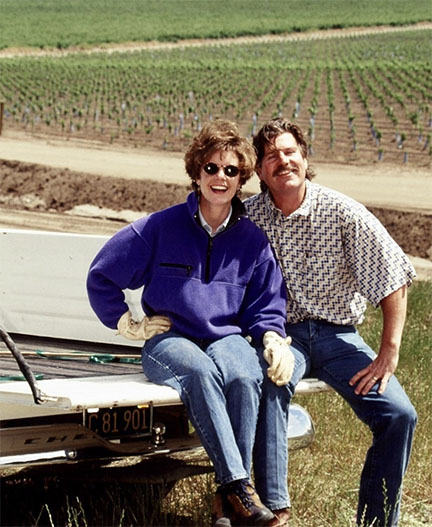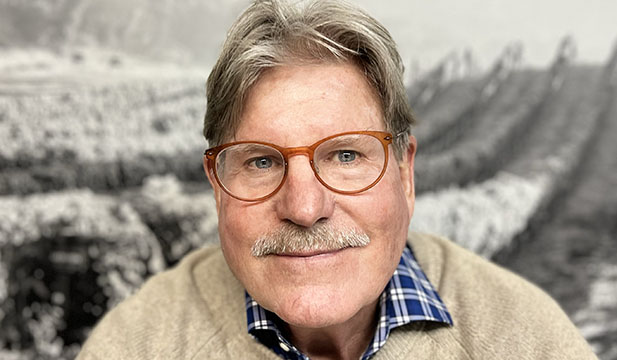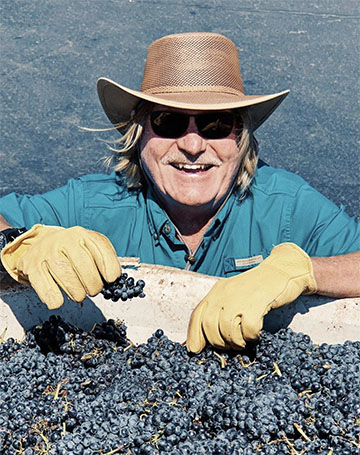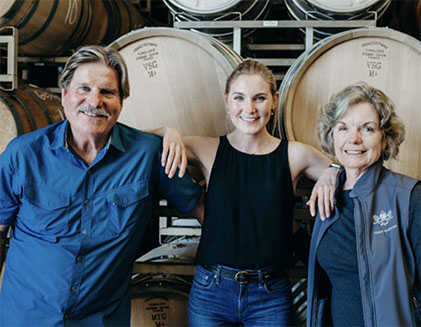The Santa Lucia Highlands sits on the east-facing terraces of the Santa Lucia mountain range to the south of Monterey Bay on California's Central Coast. In the 1790s Spanish missionaries and conquistadors planted the first vinifera wine grapes here but for the next two centuries the area focused more on vegetable farming than on viticulture. Winemaking really started to redevelop as an industry in the 1970s with the emergence of a handful of family wineries. The Santa Lucia Highlands officially became an AVA in 1991. It is 18 miles long with elevations ranging from 40 to 2,300 feet. Today there are 5,700 acres of vinifera grapevines, predominantly Pinot Noir and Chardonnay.
When Dan Morgan Lee graduated in 1978 from the enology program at UC Davis, the famous Napa Valley was where most of his classmates were drawn to. Lee chose a different path taking a head winemaker job in little known Monterey County, three hours to the south of Napa. Four years later Dan and his wife Donna Lee started Morgan Winery. At the time the area had little in terms of reputation as a quality winemaking area. Today the Santa Lucia Highlands is considered some of the best terroir in California for growing Pinot Noir and Chardonnay in the United States.
The Morgans have played an important part in the development of the Santa Lucia Highlands and their winery has been recognized for quality from the beginning with their very first Monterey Chardonnay earning a Gold Medal at the LA County Fair and a Platinum Medal from Wine & Spirits Magazine. Since then, they have won many awards including the prestigious “Winery of the Year” honors from Wine & Spirits in 1996 and from the San Francisco Chronicle in 2003.
 So how did you end up in the Santa Lucia Highlands making wine?
So how did you end up in the Santa Lucia Highlands making wine?
It really started out with my first job out of UC Davis which brought me down to the Monterey area, and I fully expected coming out of UC Davis to end up going up to Napa or Sonoma.
But there was a job opening for a new winery down in Monterey that looked interesting. It was a full winemaker job, which is interesting that most of the jobs that were being offered in Napa and Sonoma at that point in time were assistant winemakers, lab techs, you know, cellar rats and cellar masters and things like that. And so I decided I'm going to try for this full winemaking position.
(Photo: Dan and Donna Lee)
And so I put my application in and lo and behold, I went down and interviewed and I got the job. So I figured that I didn't know Monterey very well but this was a great opportunity for me to have a full winemaking job right away. And so that brought me to Monterey. It was a discovery because I had vacationed in Monterey, in Santa Cruz, quite a bit as a kid.
But I didn't really know the Salinas Valley, which is a whole different animal. And it's very cool and coastal with a marine influence. And I didn't quite realize that. So coming from where I grew up in the central California area, the Salinas Valley and UC Davis, I got this job and you know, and I was expecting it to warm up at some point in time and it never warmed up.
But look, in a nutshell, I learned about Monterey and I had some tough decisions to make. I met my future wife there. I was enjoying the wines. I loved Chardonnay and Pinot Noir, and those wines were the ones that excelled in that area. And so after thinking about it, I decided that maybe Monterey is the best place for me to stay and not try and join all of my friends up in Napa and Sonoma.
So we actually started making wine in 1982 down there. Chardonnay first and Pinot later. But it was really before the Santa Lucia Highlands appellation came into being. The appellation was really formed around 1991. And so we were making wine there for several years. We happened to be using mostly vineyards in the future Santa Lucia Highlands appellation. So just for the love of the styles of wines, I just happened to kind of fall into the Santa Lucia Highlands.
You know, in the beginning we were purchasing all fruit. We came from very humble beginnings. We were not rich people. We were making our own way, working our way up through life. And in 1996 we got offered a piece of property in the Santa Lucia Highlands. We were fortunate enough that we had built up enough savings to be able to buy that piece of property.
And that's our future Double L Ranch and Double L Vineyard as it is now, and it was bare ground in the beginning. So you know, in a roundabout way I fell in love with Monterey and then the Santa Lucia Highlands happened. That was the best growing area in the area. So that's how we got to be where we are today.
And there weren't many people there when you started?
There were vineyards there. There had been a big planting of vineyards in there, mostly by tax shelter groups. And they were just growing grapes to avoid paying taxes. And they were managed by companies that were kind of, you know, corporate type things that weren't there because of the love of wine, they were just there to do business.
And they planted a lot of wrong grapes in the wrong area. But as we started coming in and other families, like the Francioni and Pisoni families came in, we started transitioning from row crops into grapes. There was a whole new movement of these smaller family owned wineries that were focused on quality and not just a commodities of selling grapes to big wineries outside the area.
So that whole movement was happening in the early '90s and is continuing to this day and that's people focusing on quality and not quantity and that's what's making the Santa Lucia Highlands sing these days.

Talk a little bit about the terroir, the soils, the climate that you get in the Santa Lucia Highlands.
The terroir is very interesting. We're driven by lots of cool climate fog, lots of wind in the afternoon, a fair amount of sun after the fog burns off in the morning. We have a fair amount of sun in combination with all the hillside vineyards and all the soils that were washed out of the hills into what is now the alluvial fans and our vineyard sites. So our soils are very well drained, rocky, granular soils that vineyards love, not very fertile, but that's great for growing quality grapes versus the Salinas Valley floor.
It was all silt you know, laid down by the Salinas River, very rich. You have soils, great for the lettuces and all the other row crops that are grown in the Salinas Valley during the summertime, but not very good grape land. But the elements of what we have is cool. You know, a hot day in the Highlands is maybe 80 degrees.

That's a hot day. So a very typical day. It starts off foggy and 50 degrees in the morning, fog burns off between 9:00 and 11:30 or so in the morning. We actually have the hottest part of the day between 11:30 and 1:00 where the sun is out, the fog is gone, but the winds haven't picked up. And as soon as that sun comes out then we start getting a few breezes and by afternoon there's like gale force winds blowing through there.
So you know, cool climate and the wind will actually shut down vines because the wind will actually drive vines out and they become very protective. So when there is a very windy situation in the afternoon the stomata on the leaves shut down, they stop, they shut down. So with all that, the coolness and the wind extend our whole growing season into a very long growing time in moderate temperatures.
And they found that grapes accumulate flavors during these moderate temperature times. They accumulate sugar mostly in warmer areas. So we have a very slow sugar accumulation and a very high flavor accumulation happening all at the same time. And that's what adds to the great flavors of our grapes in the Santa Lucia Highlands.
What is it about the Santa Lucia Highlands that makes it particularly good for Pinot Noir? And how would you characterize a Pinot Noir from the Santa Lucia Highlands?
As you know, we have an extended growing time and we have enough heat. We can pluck, leaf pull more leaves and expose those clusters to sunlight more because it's so rare to have a blistering hot day. You know like when it reaches 85 it's like we can't believe it.
So with more sunlight it colors the fruit up. So you notice that Santa Lucia Highlands Pinots are usually really dark in color and with a long growing season with this flavor accumulation, it is perfect. And so ultimately I find the flavors that come out in SLH Pinot is kind of a cherry berry base with a little bit of cola, a little bit of smoky leather, a little bit of dried herbs in there and kind of a nice melange of flavors and aromas that are very interesting that especially the Pinot Noir lovers really enjoy.
And so it's this combination, the flavors, I think, that are a very pleasant mix. It makes the Pinots very, very good.
You farm organically. Talk a little bit about the thought process behind that and also how you feel it's reflected in the wines that you make.

We decided to go the organic route for two reasons. One, we kind of felt so lucky to be able to purchase this vineyard in the SLH. You know, the land there changes hands very, very rarely. So to have a piece was just wonderful to us. We thought, how are we going to treat this piece of land? The very best way, how are we going to be the best stewards?
And what came to mind is just doing everything as good as possible there. And organics came to mind immediately. We figure that if we farm organically, we're really kind of stepping the lightest on the land. And also stepping the lightest on, ultimately the fruit that comes off the vineyards. And so we decided to do that.
Nobody else was doing it. So it was a challenge we went into in a mindful way in that we thought we'd just give it a try and we hope it works but if it doesn't, that's fine. We're not going to destroy the economic value of our company trying to do organic. We'll go conventional. But the nice thing is that it worked.
And the added bonus, I think, is that because we use all kinds of everything for mildew control, which is our biggest challenge there, all our products are approved by the National Organic Program. They're very mild soft products. And so we feel that the terroir of our fruit coming off that vineyard really shows through in the purest form because we're not using these weird chemicals that other people are using.
Talk a little bit about the philosophy of winemaking.
We kind of feel like a good chef. You buy the best quality products going into it. You use those products almost like if you can show the quality of those products off best by doing the least possible in the kitchen, you're way better off. And that's our philosophy in the winery as well.
We figured that we got great starting material. We used no sulfur on the grapes in the beginning. We only use a little bit of sulfur after fermentation. That's just for preservation in the bottle because, you know, our wines will last in the bottle. But our sulfur levels are very, very, very low overall compared to other wineries. And we just don't manipulate a lot, we just let it develop on its own, primarily with the addition of really good quality oak barrels for the wines that can handle some oak.
And we're very judicious with the amount of oak we use, but there again, we use the very best oak barrels we can. All 100% French oak barrels from the top producers in the world. And we do a light filtration going into the bottle just to guarantee that we're going to have stable wines that will last 20 or 30 years without too much worry.
 Did you want to just mention your barrel program?
Did you want to just mention your barrel program?
So part of that whole thing about picking the very best in grapes is what you use after. The grapes I think are probably 85% of the flavor and quality of the wine and the oak probably contributes another 5 to 10% of the quality.
So we're very picky about our barrels and we were lucky to be able to develop relationships with like let's say the François Frères of cooperage out of Burgundy who Domaine de la Romanée-Conti use, 100% François Frères barrels. That's the bulk of the barrels in our program. The same barrels, wonderful barrels, and so there again is that idea of "quality in equals quality out" pretty much carries forward in our barrel program as well.
You arrived in 1978. A lot has changed in the Santa Lucia Highlands, there are a lot more people there. What are your hopes for the future and how do you see the landscape now in the center of the Santa Lucia Highlands?
The future I think is based on the fact that we have a Santa Lucia Highlands growers group that I think is getting the word out. Probably out here on the East Coast where we haven't done as good a job in advertising the great quality of the Santa Lucia Highlands. And so I think that it's just getting our area known. Always improving, looking at new grape clones like we have at the Double L Vineyards, our estate vineyards, which are organically grown. We have 13 different clones of Pinot on there right now, eight different clones of Chardonnay and we're always looking at what is new and great and what's happening out there.
And as you know, when one section of the vineyard gets kind of old and it's not doing really well we think about how we can replace that with something new and exciting. So just trying to improve on what we're doing right now, I think is just our program for the future.
Touch on old vines and how they reflect in some of your Pinot Noir and perhaps how they've evolved over time.
The maturity of the grapevines is kind of really cool because we're about 25 years old now at the Double L Vineyard, but when they reached around ten or 12 years old we really saw that they lost their youth and rambunctiousness. They started kind of stepping back and saying hey, there's more to this than trying to produce a bunch of grapes. They started moderating themselves. They started to kind of take life a little bit easier. They put out less crop every year and self-moderated and it made our life a lot easier because before we had to go in and to keep quality up we had to thin a lot. Pick too many grapes off the vines and make it more moderate. Now, we hardly have to do that. All because the vine just does it on its own with maturity, with age. And so it's really a nice situation and on top of that, we're finding that flavor development is happening earlier with these older vines.

So our alcohol levels in our wine are actually coming down. We're finding that we're getting great flavors at 20, 22 Brix instead of 24 these days so we're picking more in the 20, 22 to 23 Brix levels of maturity and making wines that are consistently a little bit above 14%. We're making wines now which most are just under 14 or maybe just across the bridge a little bit and we're floating on that 14% level alcohol. Most of our wines right now are more like 14. So we're finding with the maturity that we get flavors early on, we don't want to make alcohol per se. So we pick earlier, make lower alcohol and I think more balanced wines. We want to make wine that is good for people to drink several glasses of wine and still feel good the next morning.
(Photo: Dan with daughter Jackie and wife Donna)
You remained a family company.
We're family owned and our next generation is coming in. One of our daughters has been working for us for five years now. She's going to take over. Our other daughter is working with us right now. She is just going to go off and do something else, but maybe come back. So we're very much family-run, very consistent quality year in, year out. Our wines, I think, are the most consistent in the world.
And we focus on quality. We make quality wines. That's our focus. And then also we cherish value. We want wine priced such that people can drink and not just rich people, but everyday people. So we really focus on value as well. So those things, I think, kind of incorporate the whole Morgan Winery philosophy perfect.














